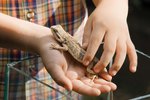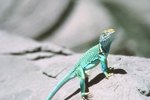Bearded dragons -- originally from Australia -- are hot-weather lizards that have been domesticated as household pets. While bearded dragons are social animals, they only fully socialize with other bearded dragons, so it is recommended to have more than one. Most bearded dragons form a dominance hierarchy, allowing them to live and socialize with one another in the same cage. However, putting two lizards of dramatically different sizes in the same cage is not recommended. The larger lizard might end up eating the smaller lizard, or simply intimidating him.
Appearances
Bearded dragons come in a variety of colors -- red, orange, yellow and beige -- with a variety of dark spots covering their bodies. Ranging from 16 to 24 inches from snout to tail, bearded dragons are considered relatively large reptiles. They have long claws designed for climbing rocks in its natural habitat, Australia. The bearded dragon, however, has one trademark -- its soft scaly skin. The bearded dragon has the ability to puff out its throat, which causes the scales on its throat to look spiky. These spiky scales on its throat give the impression of a beard.
Behaviors
When threatened or when marking its territory, the bearded dragon will open their mouth and push out their throat, to show its beard. When extremely defensive, bearded dragons will flatten out their bodies and show its beard, which will also turn black. In a group of bearded dragons, the dominant male will swiftly bob its head up and down, to show it is the leader. The others will slowly bob their heads up and down back, to show their submission. Lifting one of their forelegs and making a circular motion with it, is another sign of submission among the bearded dragons. All the communication between bearded dragons allows them to live together peacefully.
General Care
Bearded dragons are omnivores, so they eat both critters and plants. Although they will eat just about anything, crickets and green vegetables will provide them with the correct amount of nutrition. Never feed bearded dragons anything larger than the length of the space between their eyes. Anything too large will cause bearded dragons to become paralyzed from terminal indigestion; this will eventually kill them after a few hours. Since bearded dragons are accustomed to desert-like conditions, their bodies take water from what they eat. Adults, therefore, do not need water dishes. Baby bearded dragons however, will need water for the first year of life. Spray their faces with water twice a day. Their face will absorb the moisture, and this will be used as a source of water -- along with the crickets they are fed.
General Maintenance
Bearded dragons require a general care, as does any animal. When a bearded dragon is first hatched, it requires extreme care until it reaches full size in the first year of its life -- growing 13 to 16 inches. Bearded dragons should be taken to the vet at least once a year and should be checked for parasites, especially in the first 6 to 9 months of life. Each year bearded dragons will undergo a skin-peeling process, where their old, dry skin will peel to reveal a new, softer skin underneath. During this process, their skin should not be manually peeled, or else the new skin will be damaged. Giving bearded dragons warm baths will help the peeling process along -- without damaging the new skin.
References
Photo Credits
-
BananaStock/BananaStock/Getty Images
Writer Bio
Rich Quayshaun has been writing professionally since 2008. His work appears on various websites, including Just Ask Kim. He received his massage therapy certification from the Technical College of the Lowcountry and is pursuing a Bachelor of Arts in psychology and journalism from the University of Michigan in Dearborn.





